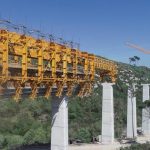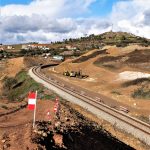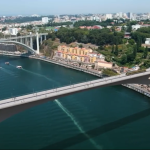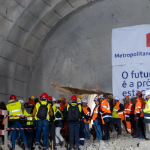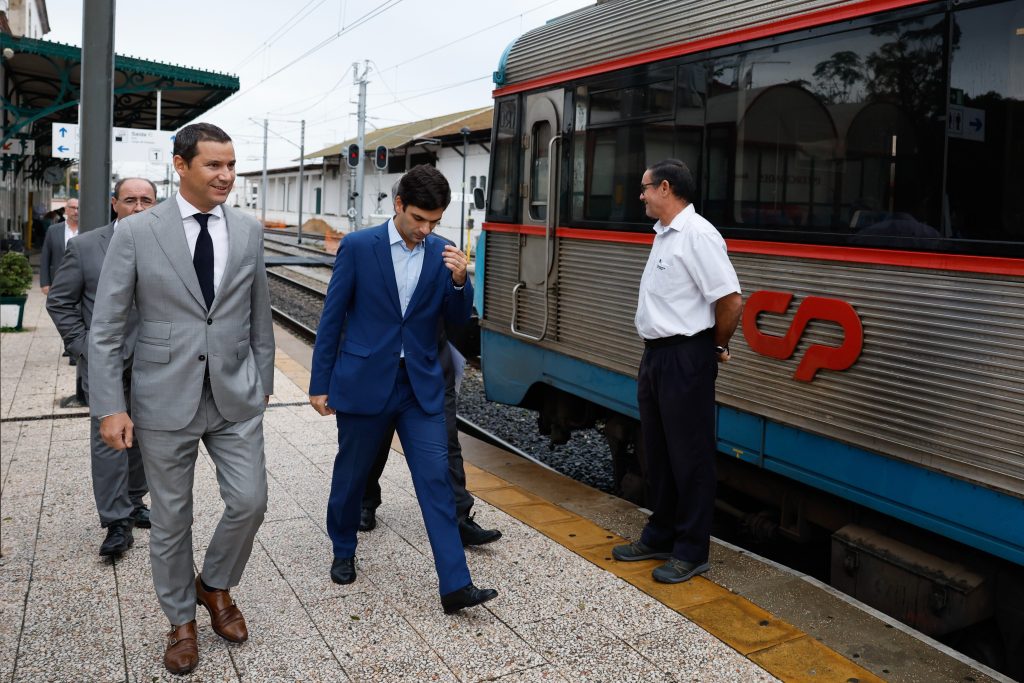 Portugal’s Minister of Infrastructure, João Galamba, has announced that the 2024 governmental budget will deliver an investment of EUR 700 million to complete ongoing works on the Portuguese railway network and EUR 1.34 billion for the expansion of public transport infrastructure and fleet procurement.
Portugal’s Minister of Infrastructure, João Galamba, has announced that the 2024 governmental budget will deliver an investment of EUR 700 million to complete ongoing works on the Portuguese railway network and EUR 1.34 billion for the expansion of public transport infrastructure and fleet procurement.
One of the actions covers the conclusions of the studies and projects and the release of tender procedures for the construction of the first section of the Porto – Lisbon high-speed line between Aveiro (Oiã) and Porto (Campanhã).
Other projects include the complete electrification of Algarve Line and the West Line (Linha Oeste) between Meleças and Caldas da Rainha, which will allow new rolling stock to be deployed to these lines, providing a better rail service.
In 2024, the ambitious investment programme will continue in the requalification and modernisation of the Portuguese railway network, based on the completion of the projects of the Ferrovia 2020 Investment Programme and the development of initiatives included in the National Investment Programme 2030 (PNI 2030).
Stand out as the main ongoing interventions, in an advanced stage of implementation, the modernisation of the Beira Alta Line, the construction of the new Alentejo Line, which connects Évora to Elvas, the modernisation of the Northern Line (Linha do Norte) between Espinho and Gaia (14 km), Sines Line (Linha de Sines), Cascais Line and the electrification of the Oeste and Algarve Lines. In 2024, the upgrade of Douro Line is also expected to continue, with the start of work on the section Marco/Régua.
In the next year, the manufacturing up to 117 new multiple units for Comboios de Portugal will start that when delivered up to 62 units will enter services in Lisbon and Porto and up to 55 will be used for regional services. Six shortlisted bidders have been selected for the supply of the new train fleet. At the same time, the rehabilitation of the existing rolling stock will continue in order to meet the transport demand until the delivery of the new railcars with a view to improving and increase the offer of Comboios de Portugal. It is also planned to carry out the project called «Portuguese Train» (Comboio Português), through manufacture of a nationally produced prototype train, with a view to assessing its commercial viability. This project financed by European funds.
In addition, in 2024, the Mondego Mobility System (SMM) is scheduled to come into operation, starting with the Suburban – Serpins – Alto de S. João section and then the Urban – Alto de S. João – Portagem section. The first phase of SMM will structurally change mobility in the Coimbra region, the Centro Region of Portugal. The entry into service of the Metrobus type services will serve the population of the Coimbra, Miranda do Corvo and Lousã municipalities, delivering high performance and frequency transport services.
Of particular relevance in 2024, the climate-related investments include projects in area of railway and public transport, which amount to EUR 1.34 billion covering the expansion of the Porto and Lisbon metro networks as well as the Mondego Mobility System and fleet acquisition procedures.
Projects:
In September 2022, the government announced the Porto – Lisbon high-speed rail project covering a 336 km long line with an estimated investment of EUR 5 billion.
The first phase of the new high-speed line covers the section between Aveiro, Porto-Campanhã and Soure which will include stations in Coimbra, Aveiro, Gaia and Porto-Campanhã. The implementation of the first phase of the new high-speed line also includes the construction of a new rail branch over the Douro River, between Porto and Vila Nova de Gaia. Works are expected to be completed in 2028. The second phase of the project covers the line between Soure and Carregado which would be completed in 2030, while the development of the remaining third phase from Carregado to Lisboa-Oriente is expected to start beyond 2030.
When completed, the Porto – Lisbon high-speed rail will reduce CO2 emissions by 3 million tonnes by 2050.
In august 2023, Infraestruturas de Portugal announced that the first section of the high-speed line between Porto and Soure will be implemented in PPP with procedures expected to begin in January 2024. This section is estimated to cost EUR 3 billion, of which EUR 1 billion is expected to be covered by the Connecting Europe Facility.
The electrification of the 140 km Algarve Line, in south Portugal, is expected to be completed in 2024, the Minister of Infrastructure, João Galamba, announced in October 2023. The project is implemented into two sections with the first one between Faro and Vila Real de Santo António ans the second one between Tunes and Lagos. At the same time, works are ongoing for the modernisation of the tracks as well as the deployment of modern signalling and telecommunications systems, the installation of passenger information systems at all stations and the removal of the existing level crossings. In November 2021, Infraestruturas de Portugal (IP) signed a EUR 20.45 million contract with Sacyr Neopul-Sacyr Somague consortium for the electrification of the 56 km Faro – Vila Real de Santo António section, including the installation of signalling and telecommunications systems.
In February 2022, IP awarded a consortium of Comsa Instalaciones y Sistemas Industriales, Fergrupo – Construções Técnicas Ferroviárias, and Comsa a EUR 25.4 million contract for the electrification of the 45 km Tunes – Lagos section.
The electrification of Algarve Line has a value of EUR 89 million, of which EUR 49 million is the European co-financing. When the project is completed, travel time will be reduced by 25 minutes, reducing the traffic in the Algarve metropolitan area.
The upgrade and electrification of Western Line (Linha Oeste) is divided into two main sections. The first one covers the 45 km section between Mira Sintra-Meleças and Torres Vedras with a EUR 61.5 million investment, while the second 44 km Torres Vedras – Caldas da Rainha section is worth EUR 38.4 million. The project will increase transport capacity and efficiency of the rail services, improving availability and reducing journey times by 30 minutes. The modernised and electrified line will increase rail services from 16 to 48 in both directions.
In 2024, rehabilitation works on Beira Alta Line between Pampilhosa and Guarda (190 km) will also continue. Besides comprehensive track renewal, the project also includes the installation of ETCS Level 2, the modernisation of 10 stations to allow 750-metre-long strains, the removal of the level crossings as well as the construction of Mealhada branch providing direct rail connection between Northern Line (Linha do Norte) and the Beira Alta Line.
The modernisation of Beira Alta Line started in 2019 with works on the 202 km Pampilhosa – Vilar Formoso expected to be completed this month, but this deadline is not to be met. In October 2022, the rail infrastructure manager postponed the reopening of Pampilhosa – Guarda section by six months due to the measures and effects of pandemic and war in Ukraine. The modernisation of the Beira Alta line, which was launched in 2019, will take 19 months, 10 more than originally planned, in April 2023 was announced.
The Alentejo Line project covers the modernisation of Casa Branca – Beja section and the construction of the second track between Poceirão and Bombel (22 km). The project also includes the construction of a rail connection to Beja Airport. The entire project will boost competitiveness of the rail transport at international level including the Lisbon – Madrid axis and at a regional level, between the regions of Alentejo and Lisbon and Tagus Valley.
Under the PNI 2030, IP is modernising the Alverca – Castanheira section and quadrupling Castanheira – Azambuja section on the Northern Line (Linha do Norte) and is extending the 34.6 km Ermidas do Sado – Grândola section on Linha Sines. Works on the 25 km Cascais Line which connects Lisbon cover the modernisation of the tracks, signalling and control systems including the installation of the ETCS L2. For this project, the EU through the Cohesion Fund, provided EUR 50 million co-financing in 2020.
Regarding the public transport projects, the two important Portugues cities are carrying out the programmes to develop and expand their systems. Lisbon is working on projects to provide better connection between the public transport network and the heavy rail system through the Cascais Line. Recently, Metropolitano de Lisboa has announced the five bidders for the design and construction of the 4 km Red Line extension between São Sebastião to Alcântara, estimated at EUR 330 million. According to the project’s schedule, the works are expected to be completed in 2026. The City of Lisbon is implementing the Circular Line project, a 1.9 km metro extension served by two stations which will be connected with the Yellow Line. For the EUR 331 million project, the tunnel linking the between the future Estrela and Santos stations has been already excavated. The city is also working on the development of the Violet Line which will provide the connection with the municipality of Loures. The EUR 390 million project covers the construction of a 13 km line with 19 stations of which 3 underground stations. The project is expected to be completed in 2025.
In addition, Metropolitano de Lisboa awarded a EUR 114.5 million contract to Stadler – Siemens Mobility consortium to supply 14 three-car metro trains and install the CBTC system on Blue, Green and Yellow lines.
The City of Porto launched in May the tender for the construction of the 6.3 km Ruby metro Line with 8 stations (of which 5 underground) which will connect Casa da Música, in Porto, to Santo Ovídio, in Vila Nova de Gaia. The project includes the construction of a new835 metre-long bridge over the Douro River. The construction contract is estimated at EUR 370 million and EUR 435 million is the value of the entire project, with EUR 299 million covered through the Recovery and Resilience Plan. Porto Metro has also awarded Alstom a contract to supply the signalling, safety and control systems for the 3.1 km Yellow metro line extension with three new stations.
Share on:





